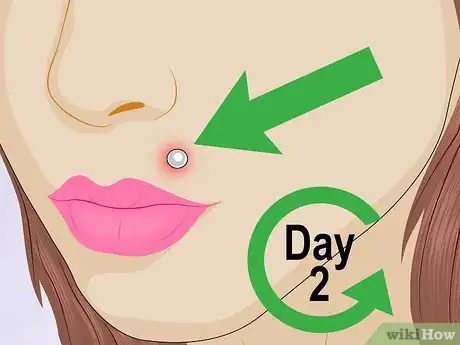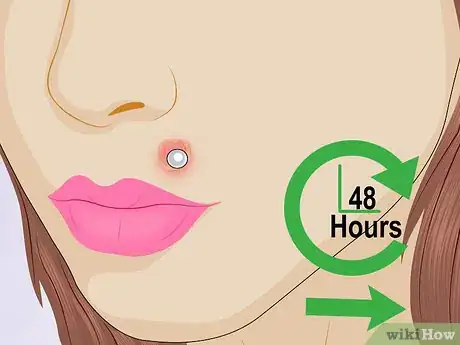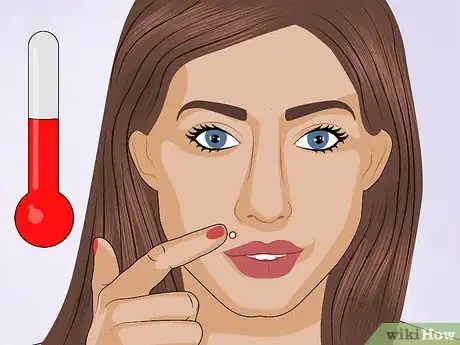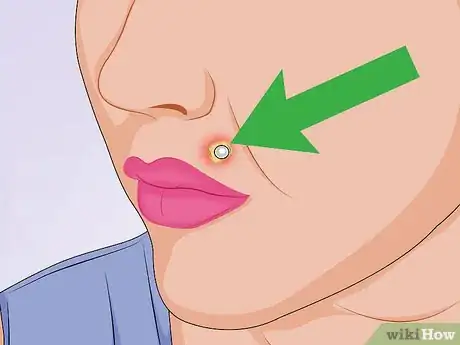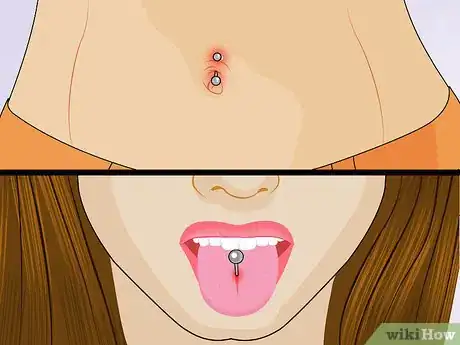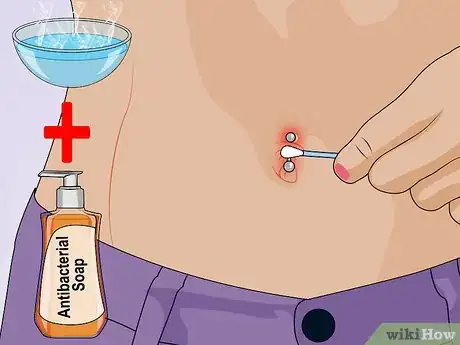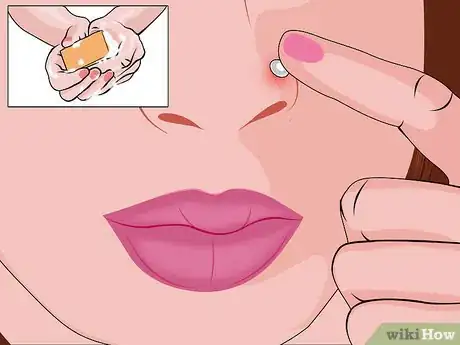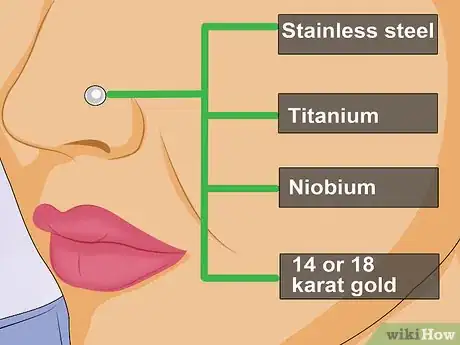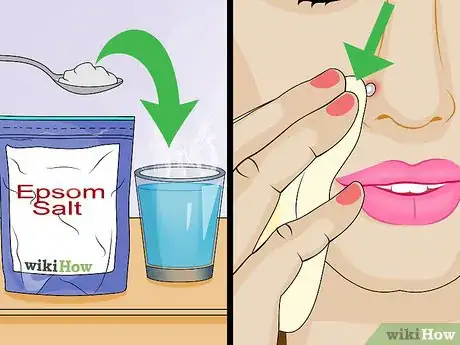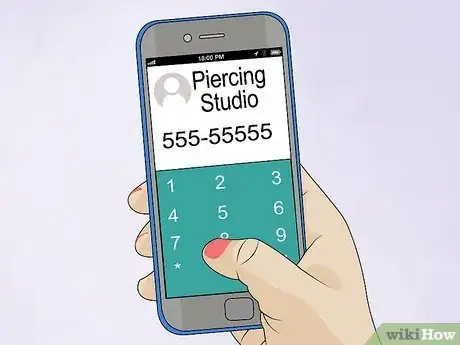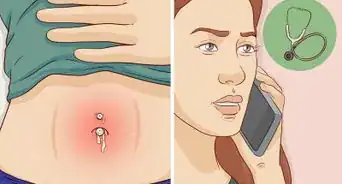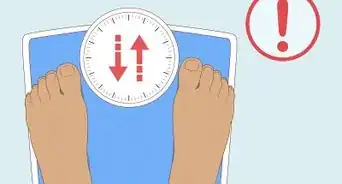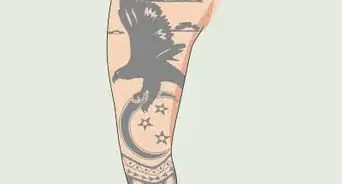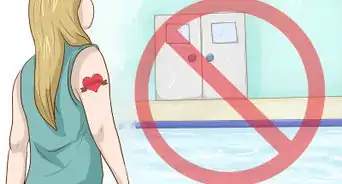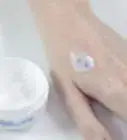This article was medically reviewed by Sarah Gehrke, RN, MS. Sarah Gehrke is a Registered Nurse and Licensed Massage Therapist in Texas. Sarah has over 10 years of experience teaching and practicing phlebotomy and intravenous (IV) therapy using physical, psychological, and emotional support. She received her Massage Therapist License from the Amarillo Massage Therapy Institute in 2008 and a M.S. in Nursing from the University of Phoenix in 2013.
There are 7 references cited in this article, which can be found at the bottom of the page.
wikiHow marks an article as reader-approved once it receives enough positive feedback. This article received 24 testimonials and 93% of readers who voted found it helpful, earning it our reader-approved status.
This article has been viewed 2,799,196 times.
You just got a new piercing and you’re not sure whether what you’re experiencing is a normal part of the healing process, or worse – an infection. Learn to recognize signs that your piercing is infected so that you can treat it properly, keeping it healthy and looking good. Pay attention to pain, swelling, redness, heat, pus, and more serious symptoms; and always be sure to follow proper techniques to avoid infection whenever possible.
Steps
Recognizing Signs of Infection
-
1Look for worsening redness. It’s normal for a fresh piercing to be pink; you just received a puncture wound, after all. However, redness that get worse or spreads to a larger area is a sign of possible infection.[1] Keep an eye on your piercing or take photos of it and make a note about whether your redness is improving or worsening over a day or two.
-
2Notice any swelling. The area around your new piercing will likely swell for about 48 hours as your body adjusts to what it perceives as an injury. After that time, swelling should start to go down. Worsening swelling, swelling that appears after a time of being normal, and swelling accompanied by redness and pain are symptoms of infection.[2]
- Swelling can cause loss of function, like if your tongue gets swollen and doesn’t move easily. If the area around your piercing is too painful or swollen to move, you could have an infection.
Advertisement -
3Pay attention to pain. Pain is your body’s way of telling you something is wrong. The original pain from your piercing should subside within two days or so, around the same time that swelling starts to decrease. It’s normal for this pain to be stinging, aching, burning, or tender. Pain lasting longer than a couple of days or that gets worse may indicate infection.[3]
- Of course, if you accidentally irritate your new piercing you’ll probably experience some pain. It’s pain that gets worse or doesn’t go away that you want to watch out for.
-
4Feel if the area is hot. With redness, swelling, and pain, comes heat. If your piercing is really inflamed or infected it might feel like it’s giving off heat or even feel hot to the touch.[4] If you’re going to touch your piercing area to check for heat, always wash your hands first.
-
5Look for any discharge or pus. It is very normal and healthy for a new piercing to ooze some clear or straw-colored fluid that then might crust around the jewelry. This is lymph fluid, and it is a part of the healing process. On the other hand, thick whitish or colored discharge (yellow, green) is probably pus. Pus might also have an unpleasant odor.[5]
- Any thick, milky, or colored discharge should be considered a likely sign of infection. See your doctor if your piercing has pus around it.
-
6Consider the age of the piercing. Discomfort you feel the day you get pierced probably isn’t infection; it generally takes a day or more for signs of infection to develop. It’s also unlikely that you will develop an infection in a piercing you have had for a long time and is already healed.
- However, infection in old piercings is possible if any sort of injury occurs to the area; any cut or opening in the skin can be a doorway for bacteria.
-
7Consider the location of the piercing. If the piercing is in an area of the body more prone to infection, you should suspect infection more quickly. Ask your professional piercer about how likely your piercing is to become infected.
- Navel piercings must be cleaned well. Because they’re in a warm, sometimes damp location they have a higher risk of becoming infected.
- Tongue piercings have higher risk of infection because of bacteria in your mouth. Because of its location tongue infections can lead to serious complications like infection of the brain.[6]
Avoiding Infections
-
1Clean your new piercing properly. Your piercer should give you specific instruction for how to clean your new piercing, including suggesting what products to use for cleaning. Different piercings have somewhat different cleaning requirements, so get clear, written instructions. In general, follow some simple guidelines:
- Clean skin piercings with warm water and non-scented antibacterial soap, like Dial, or with warm salt water.
- Don’t use rubbing alcohol or hydrogen peroxide on the new piercing. These are too harsh and can damage or irritate the skin.
- Avoid using antibiotic creams or ointments. They trap dirt and debris and do not allow the piercing to breathe.
- Clean your piercing as often as your piercer recommends – not more or less. Under-cleaning can cause buildup of dirt, crust, and dead skin. Over-cleaning can irritate and dry skin out. Both are detrimental to healing.
- Gently move or twist the jewelry while cleaning it to get the solution inside the piercing and coat the jewelry. This isn’t true for some types of piercings, so always ask your piercer first.
-
2Follow new-piercing guidelines. Other than proper cleaning techniques, taking care of your piercing can help prevent unnecessary pain and infection. Some guidelines to follow for general piercing care are:
- Don’t sleep on your new piercing. Your jewelry can rub on your blankets, sheets, or pillows, causing irritation and getting the area dirty. Sleep on your back if you got a navel piercing; if your new piercing is facial, try using an airplane support pillow and aligning your piercing with the middle "hole.”
- Wash your hands before you touch the piercing or surrounding area.[7]
- Do NOT remove the jewelry before you piercing is healed.[8] Doing so will probably let the piercing close up. If the area is infected, the infection will be trapped in your skin.
- Try not to let clothes rub directly onto new piercings. Also, do not twist your jewelry unless you’re cleaning it.[9]
- Stay out of pools, lakes, rivers, hot tubs, and other bodies of water until your piercing heals.[10]
-
3Choose a reputable professional. About 1 in 5 piercings get infected, usually because of unsterile piercing procedures or improper aftercare.[11] Only ever get pierced by a trained professional and in a reputable, clean piercing studio. Before getting pierced, insist that your piercer show you how and where their equipment is sterilized – they should have an autoclave, and clean all surfaces with bleach and disinfectant.
- Piercers should only ever pierce you with a new needle out of a sterile package, NEVER a reused needle, and they should always wear fresh, disposable gloves while piercing.[12]
- A piercing gun is NEVER appropriate. Walk out if you see a piercing gun. Go to a professional to ensure a sterile procedure.
- Check with your state legislation about what licensing and training someone needs to have in order to pierce you.
- Do NOT pierce yourself or ask an untrained friend to pierce you.
-
4Get pierced with hypoallergenic jewelry. Though having an allergic reaction to jewelry is not the same thing as getting an infection, anything that irritates your new piercing also increases the risk for infection. A severe allergy could also force you to remove your new jewelry. Always get pierced with hypoallergenic jewelry for the best chance for good healing.
- Request stainless steel, titanium, niobium, or 14- or 18-karat gold.[13]
-
5Know how long it takes for your piercing to heal. There are lots of places you can get pierced, through different types of tissue in areas that get more or less blood-flow. Thus, healing time varies a lot. Know the specifics of your piercing so you know how long you have to take extra care of it (for a specific piercing not listed, consult your professional piercer):[14]
- Ear cartilage, nostril, cheek, nipples, navel, and dermals/anchors/surface piercings: 6-12 months
- Earlobe, eyebrow, septum, lip, labret, beauty mark, and Prince Albert: 6-8 weeks
- Clitoral hood: 4-6 weeks
- Tongue: 4 weeks
Dealing With an Infection
-
1Try a home remedy if you have a mild infection. Dissolve 1 teaspoon (5 ml) of table salt, sea salt, or Epsom salt in 1 cup (250 ml) of warm water in a clean cup, preferably in a disposable plastic one for each treatment. Soak the piercing or make a compress with a clean washcloth saturated with the salt water. Do this two to three times per day, fifteen minutes per session.[15]
- If you don’t see improvement in 2-3 days, or if your symptoms get worse, contact your doctor for help.
- Be sure to cover the entire piercing with the salt soak, on both sides of the hole. Continue to clean the piercing regularly with warm water and mild antibacterial soap.
- It’s also okay to dab a small amount of antibiotic ointment onto the wound if infection is present.
-
2Call your piercer for mild problems. If you notice slight signs of infection like some redness or swelling that doesn’t go away, it’s okay to call your piercer and ask for advice on how to care for it. You can also go in to see them if you start to have drainage – they’ve seen so many piercings they can probably tell you whether the discharge is normal or not.
- This only applies if a trained professional pierced you. If not, consult a doctor with any medical questions.
-
3See your doctor if you have fever, chills, or stomach upset. Infections in piercings usually stay localized to the area of the piercing. However, if an infection spreads or gets into your bloodstream it can result in a serious, even life-threatening systemic infection. With severe infection you can have a fever, chills, nausea or vomiting, or dizziness.[16]
- If you notice that your pain, swelling, and redness near your piercing start to spread to a larger area, see your doctor right away. This might be a sign that the infection is worsening and moving to larger areas of your body.
- Your doctor will probably prescribe you antibiotics to prevent a severe infection. If the infection is already in your blood, you’ll probably have to stay in the hospital and have IV antibiotics.
Expert Q&A
-
QuestionI think I have a blood blister under the bottom of my belly piercing. It hurts and smells weird, is it infected?
 Sarah Gehrke, RN, MSSarah Gehrke is a Registered Nurse and Licensed Massage Therapist in Texas. Sarah has over 10 years of experience teaching and practicing phlebotomy and intravenous (IV) therapy using physical, psychological, and emotional support. She received her Massage Therapist License from the Amarillo Massage Therapy Institute in 2008 and a M.S. in Nursing from the University of Phoenix in 2013.
Sarah Gehrke, RN, MSSarah Gehrke is a Registered Nurse and Licensed Massage Therapist in Texas. Sarah has over 10 years of experience teaching and practicing phlebotomy and intravenous (IV) therapy using physical, psychological, and emotional support. She received her Massage Therapist License from the Amarillo Massage Therapy Institute in 2008 and a M.S. in Nursing from the University of Phoenix in 2013.
Registered Nurse The painful, foul smelling, blood blister is an infection. Keep the area clean with a warm saline solution, free of irritation (such as tight clothing), and see your doctor as soon as possible. Treatment is important so the infection doesn't get worse. It's also a good idea to let your piercer know that you are going to see the doctor, just so they can keep track of infection rates.
The painful, foul smelling, blood blister is an infection. Keep the area clean with a warm saline solution, free of irritation (such as tight clothing), and see your doctor as soon as possible. Treatment is important so the infection doesn't get worse. It's also a good idea to let your piercer know that you are going to see the doctor, just so they can keep track of infection rates. -
QuestionI have a red round bump on my navel piercing. Is this an infection? I've cleaned it twice a day with solution and 15 minute sea salt soak every night.
 Sarah Gehrke, RN, MSSarah Gehrke is a Registered Nurse and Licensed Massage Therapist in Texas. Sarah has over 10 years of experience teaching and practicing phlebotomy and intravenous (IV) therapy using physical, psychological, and emotional support. She received her Massage Therapist License from the Amarillo Massage Therapy Institute in 2008 and a M.S. in Nursing from the University of Phoenix in 2013.
Sarah Gehrke, RN, MSSarah Gehrke is a Registered Nurse and Licensed Massage Therapist in Texas. Sarah has over 10 years of experience teaching and practicing phlebotomy and intravenous (IV) therapy using physical, psychological, and emotional support. She received her Massage Therapist License from the Amarillo Massage Therapy Institute in 2008 and a M.S. in Nursing from the University of Phoenix in 2013.
Registered Nurse Sometimes, despite the cleaning you have done, the piercing can get infected. A round bump around a piercing may be an infection. Reasons for getting this bump can vary. Consult your doctor so you can get appropriate treatment. Keep up with your current cleaning regime and wear loose clothing to prevent further irritation while awaiting to see a doctor. Also, let your piercer know just in case the establishment monitors infection rates.
Sometimes, despite the cleaning you have done, the piercing can get infected. A round bump around a piercing may be an infection. Reasons for getting this bump can vary. Consult your doctor so you can get appropriate treatment. Keep up with your current cleaning regime and wear loose clothing to prevent further irritation while awaiting to see a doctor. Also, let your piercer know just in case the establishment monitors infection rates.
Warnings
- See your doctor right away if you have any full-body symptoms like nausea, vomiting, chills, dizziness, or confusion. An infection in your bloodstream is very serious and potentially life-threatening.[17]⧼thumbs_response⧽
References
- ↑ http://www.mayoclinic.org/healthy-lifestyle/adult-health/in-depth/piercings/art-20047317
- ↑ http://www.mayoclinic.org/healthy-lifestyle/adult-health/in-depth/piercings/art-20047317
- ↑ http://www.mayoclinic.org/healthy-lifestyle/adult-health/in-depth/piercings/art-20047317
- ↑ http://www.aboutkidshealth.ca/En/HealthAZ/ConditionsandDiseases/Dermatology/Pages/Pierced-Ear-Infection.aspx
- ↑ http://www.mayoclinic.org/healthy-lifestyle/adult-health/in-depth/piercings/art-20047317
- ↑ https://www.ncbi.nlm.nih.gov/pmc/articles/PMC2852294/
- ↑ http://www.mayoclinic.org/healthy-lifestyle/adult-health/in-depth/piercings/art-20047317?pg=2
- ↑ http://www.mayoclinic.org/healthy-lifestyle/adult-health/in-depth/piercings/art-20047317?pg=2
- ↑ http://www.mayoclinic.org/healthy-lifestyle/adult-health/in-depth/piercings/art-20047317?pg=2
- ↑ http://www.mayoclinic.org/healthy-lifestyle/adult-health/in-depth/piercings/art-20047317?pg=2
- ↑ http://www.huffingtonpost.com/glenn-d-braunstein-md/body-piercing_b_1525337.html
- ↑ http://www.mayoclinic.org/healthy-lifestyle/adult-health/in-depth/piercings/art-20047317?pg=2
- ↑ http://www.mayoclinic.org/healthy-lifestyle/adult-health/in-depth/piercings/art-20047317?pg=2
- ↑ https://www.infinitebody.com/body_piercing_aftercare/healing-times/
- ↑ http://woundcaresociety.org/drain-infected-ear-piercing
- ↑ http://www.aboutkidshealth.ca/En/HealthAZ/ConditionsandDiseases/Dermatology/Pages/Pierced-Ear-Infection.aspx
- ↑ https://www.ncbi.nlm.nih.gov/pmc/articles/PMC2852294/
About This Article
While it’s normal to have redness, pain, and swelling right after a piercing, you may have an infection if these symptoms get worse after 48 hours. You can also touch the area right around your piercing to see if it feels hot, which is another sign of infection. Along with these symptoms, you may also have whitish, yellowish, or greenish discharge, possibly with an unpleasant odor. There’s a good chance your infection will go away on its own if you clean the area 2 to 3 times a day with a saltwater solution. However, if you begin to experience symptoms like chills, fever, headaches, and stomach upset, see a doctor right away since you’ll likely need antibiotics to treat the infection. For more advice, like how to make an Epsom salt solution for your infection, keep reading.
